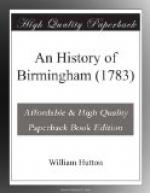It appeared in the course of the trial, that the ancestors of William de Birmingham had a MARKET HERE before the Norman conquest! I shall have occasion, in future, to resume this remarkable expression. I have also met with an old author, who observes, that Birmingham was governed by two Constables in the time of the Saxons; small places have seldom more than one. These evidences prove much in favour of the government, population, and antiquity of the place.
In Domesday-book it is rated at four hides of land. A hide was as much as a team could conveniently plough in a year; perhaps at that time about fifty acres: I think there is not now, more than two hundred ploughed in the parish.
It was also said to contain woods of half a mile in length, and four furlongs in breadth. What difference subsisted between half a mile and four furlongs, in ancient time, is uncertain; we know of none now. The mile was reduced to its present standard in the reign of Queen Elizabeth: neither are there the least traces of those woods, for at this day it is difficult to find a stick that deserves the name of a tree, in the whole manor.—Timber is no part of the manufactory of Birmingham.
Let us survey the town a third time, as we may reasonably suppose it stood in the most remarkable period of English history, that of the conquest.
We cannot yet go farther North of the centre than before, that is, along the High-street, ’till we meet the East end of New street. We shall penetrate rather farther into Moor-street, none into Park-street, take in Digbeth, Deritend, Edgbaston-street, as being the road to Dudley, Bromsgrove, and the whole West of England; Spiceal-street, the Shambles, a larger part of Bell street, and Philip-street.
The ancient increase of the town was towards the South, because of the great road, the conveniency of water, the church, and the manor-house, all which lay in that quarter: but the modern extension was chiefly towards the North, owing to the scions of her trades being transplanted all over the country, in that direction, as far as Wednesbury, Walsall, and Wolverhampton. But particularly her vicinity to the coal delphs, which were ever considered as the soul of her prosperity. Perhaps by this time the number of houses might have been augmented to seven hundred: but whatever was her number, either in this or any other period, we cannot doubt her being populous in every aera of her existence.
The following small extract from the register, will show a gradual increase, even before the restoration:
Year. Christenings. Weddings. Burials 1555, 37, 15, 27. 1558, 48, 10, 47. 1603, 65, 14, 40. 1625, 76, 18, 47. 1660, 76, from April to Dec. inclusive.
In 1251, William de Birmingham, Lord of the Manor, procured an additional charter from Henry the Third, reviving some decayed privileges and granting others;




